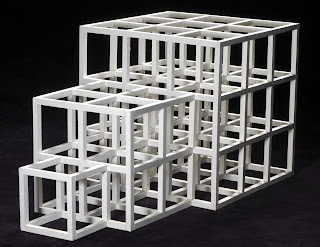Voilà l'occasion rêvée de vous renseigner sur cet artiste, minimal et conceptuel, mort depuis maintenant 5 ans.
Il naît en 1927, dans le Connecticut. Très tôt poussé vers l'art par sa mère, il continu sur cette route jusqu'au bachelor of fine art qu'il décroche à l'université de Syracuse.
Pour poursuivre sa formation, il part en Europe se confronter au grand maître.
Quelques temps après, il doit repartir, pour cette fois ci se confronter au Coréen, durant la guerre de Corée.
Dès son retour, il s'installe à New York, the big apple. Il y continu ses études et multiplie les petits boulots.
Il travaille notamment dans le cabinet d'architecte de Ieoh Ming Pei (l'indiscutable Pyramide du Louvre, l’étonnante Biosphère 2 et bien d'autre).
Travaillant au Museum of Modern Art (MoMA) à NY, il y rencontre les artistes Robert Ryman, Dan Flavin et Robert Mangold, ainsi que la critique Lucy R. Lippard.
D'abord classé dans la case minimaliste, il s'en détache en essayant de favoriser une approche conceptuel dans son travail.
Il considérait par exemple que l'essentiel d'une oeuvre se joue dans sa conceptualisation et que son exécution n'en est qu'une tâche mineure.
Pour ce qui sont chaud ou pour ceux qui vivent près de Metz, n’hésitez pas l'expo se termine le 29 juillet.
Pour les autres, je vous laisse avec 35 phrases sur l'art conceptuel de Sol Lewitt.
1) Conceptual Artists are mystics rather than rationalists. They leap to conclusions that logic cannot reach.
2) Rational judgments repeat rational judgments.
3) Illogical judgments lead to new experience.
4) Formal art is essentially rational.
5) Irrational thoughts should be followed absolutely and logically.
6) If the artist changes his mind midway through the execution of the piece he compromises the result and repeats past results.
7) The artist’s will is secondary to the process he initiates from idea to completion. His willfulness may only be ego.
8) When words such as painting and sculpture are used, they connote a whole tradition and imply a consequent acceptance of this tradition, thus placing limitations on the artist who would be reluctant to make art that goes beyond the limitations.
9) The concept and idea are different. The former implies a general direction while the latter is the component. Ideas implement the concept.
10) Ideas alone can be works of art; they are in a chain of development that may eventually find some form. All ideas need not be made physical.
11) Ideas do not necessarily proceed in logical order. They may set one off in unexpected directions but an idea must necessarily be completed in the mind before the next one is formed.
12) For each work of art that becomes physical there are many variations that do not.
13) A work of art may be understood as a conductor from the artists’ mind to the viewers. But it may never reach the viewer, or it may never leave the artists’ mind.
14) The words of one artist to another may induce a chain of ideas, if they share the same concept.
15) Since no form is intrinsically superior to another, the artist may use any form, from an expression of words (written or spoken) to physical reality, equally.
16) If words are used, and they proceed from ideas about art, then they are art and not literature, numbers are not mathematics.
17) All ideas are art if they are concerned with art and fall within the conventions of art.
18) One usually understands the art of the past by applying the conventions of the present thus misunderstanding the art of the past.
19) The conventions of art are altered by works of art.
20) Successful art changes our understanding of the conventions by altering our perceptions.
21) Perception of ideas leads to new ideas.
22) The artist cannot imagine his art, and cannot perceive it until it is complete.
23) One artist may misperceive (understand it differently from the artist) a work of art but still be set off in his own chain of thought by that misconstruing.
24) Perception is subjective.
25) The artist may not necessarily understand his own art. His perception is neither better nor worse than that of others.
26) An artist may perceive the art of others better than his own.
27) The concept of a work of art may involve the matter of the piece or the process in which it is made.
28) Once the idea of the piece is established in the artist’s mind and the final form is decided, the process is carried out blindly. There are many side effects that the artist cannot imagine. These may be used as ideas for new works.
29) The process is mechanical and should not be tampered with. It should run its course.
30) There are many elements involved in a work of art. The most important are the most obvious.
31) If an artist uses the same form in a group of works and changes the material, one would assume the artist’s concept involved the material.
32) Banal ideas cannot be rescued by beautiful execution.
33) It is difficult to bungle a good idea.
34) When an artist learns his craft too well he makes slick art.
35) These sentences comment on art, but are not art.






.jpg)
Aucun commentaire:
Enregistrer un commentaire